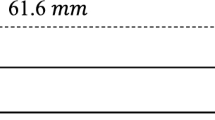Abstract
In some angiographic methods for measurement of mean coronary flow in ml/min, a threshold is applied to ‘concentration-distance’ curves obtained from a constant rate injection by computing the intravascular contrast medium concentration along the main coronary branches. If the shape of the velocity profile would remain parabolic throughout the cardiac cycle, the correct threshold value would be ‘50% of the concentration at the injection site’. But, coronary flow being strongly pulsatile, the shape of the velocity profile must be expected to vary appreciably within the cardiac phase. In order to investigate if a single, appropriate threshold value nevertheless exists for a great variety of coronary flow pulses and velocity profiles, the spreading of contrast medium injected continuously in a tube perfused by a time varying flow Q(t) was studied by computer simulation. While the particular time courses of flow and velocity profile appear to be of secondary importance, the ratio ‘injection rate to peak coronary flow’ has a major impact. If it is equal to or greater than 1, a threshold value of 47% is the best choice. If the ratio is markedly less than 1, no appropriate threshold exists and use of the 47% threshold will result in considerable flow underestimations. This was fully confirmed by measurements of absolute coronary flow performed in patients.
Similar content being viewed by others
References
Guggenheim N, Doriot PA, Dorsaz PA, Descouts P, Rutishauser W. Spatial reconstruction of coronary arteries from angiographic images. Phys Med Biol 1991; 36(1): 99–110.
Guggenheim N, Chappuis F, Suilen C, Doriot PA, Dorsaz PA, Descouts P, Rutishauser W. 3D-reconstruction of coronary arteries in view of flow measurement. Intern J Cardiac Imaging 1992; 8: 265–72.
In: A symposium: The clinical applications of the intracoronary Doppler guidewire. Reprinted from May 20, 1993, Am J Cardiol 1993; 71(14).
He X, Ku DN, Moore JE Jr. Simple calculation of the velocity profiles for pulsatile flow in a blood vessel using mathematica. Annals Biomed Engineering 1993; 21: 45–9.
Rutishauser W, Bussman WD, Noseda G, Meier W, Wellauer J. Blood flow measurement through single coronary arteries by roentgen densitometry. Part 1. A comparison of flow measured by a radiologic technique applicable in the intact organism and by electromagnetic flowmeter. Am J Roentgenol 1970; 109: 12–20.
Bürsch JH, Ritman EL, Wood EH, Sturm RE. Roentgenvideodensitometry. In: Bloomfield DA, (ed). Dye curves: The theory and practice of indicator dilution. Baltimore: Univ Park Press, 1974: 313–33.
Bürsch JH, Hahne HJ, Brennecke R, Gronemeier D, Heintzen PH. Assessment of arterial blood flow, measurements by digital angiography. Radiology 1981; 141: 39–47.
Simon R, Herrmann G, Amende I. Comparison of three different principles in the assessment of coronary flow reserve from digital angiograms. Intern J Cardiac Imaging 1990; 5: 203–12.
Vogel RA, LeFree M, Bates E, O'Neill W, Foster R, Kirlin P, Smith D, Pitt B. Application of digital techniques to selective coronary arteriography: Use of myocardial contrast appearance time to measure coronary flow reserve. Am Heart J 1984; 107: 153–64.
Hodgson JMcB, Legrand V, Bates E, Mancini GBJ, Aueron FM, O'Neill WW, Simon SB, Beaumann GJ, LeFree M, Vogel RA. Validation in dogs of a rapid digital angiographic technique to measure relative coronary blood flow during routine cardiac catheterization. Am J Cardiol 1985; 55: 188–98.
Cusma JT, Toggart EJ, Folts JD, Peppier WW, Hangiandreou NJ, Lee C, Mistretta CA. Digital subtraction angiographic imaging of coronary flow reserve. Circ 1987; 75(2): 461–72.
De Bruyne B, Dorsaz PA, Doriot PA, Meier B, Finci L, Rutishauser W. Assessment of regional coronary flow reserve by digital angiography. Intern J Cardiac Imaging 1988; 3: 47–55.
Reiber JHC, Zijlstra F, van Ommeren J, Serruys PW. Relation between coronary flow reserve and severity of coronary obstruction, both assessed for coronary cineangiogram. In: Heintzen PH & Bürsch JH, (eds). Progress in digital angiocardiography. Dordrecht: Kluwer Academic Publishers, 1988: 275–91.
Haude M, Brennecke R, Erbel R, Lang M, Deutsch HP, Renneisen U, Meyer J. Parametric assessment of myocardial perfusion during interventional cardiac catheterization by means of x-ray densitometry — Short- and long term results. Intern J Cardiac Imaging 90; 5: 183–90.
Spiller P, Schmiel FK, Pölitz B, Block M, Fermor U, Hackbarth W, Jehle J, Körfer R, Pannek H. Measurement of systolic and diastolic flow rates in the coronary artery system by X-ray densitometry. Circ 1983; 68(2): 337–47.
Fencil LE, Doi K, Chua KG, Hoffman KR. Measurement of absolute flow rate in vessels using a stereoscopic system. Phys Med Biol 1989; 34(6): 659–71.
Spiller P, Jehle J, Pölitz B, Schmiel FK. A digital X-ray image processing system for measurement of phasic blood flow in coronary arteries. Comp Cardiol 1982; 223–6.
Swanson DK, Myerowitz PD, Hegge JO, Watson KM. Arterial blood-flow waveform measurement in intact animals: New digital radiographic technique. Radiology 1986; 161: 323–8.
Colchester ACF, Hawkes DJ, Brunt JNH, du Boulay GH, Wallis A. Pulsatile blood flow measurements with the aid of 3-D reconstructions from dynamic angiographics recordings. In: Bacharach SL, (ed). Information processing in medical imaging. Boston: Martinus Nijhoff Publishers, 1986: 247–65.
Parker D, Pope DL, van Bree R, Marshall HW. Threedimensional reconstruction of moving arterial beds from digital subtraction angiography. Comput Biomed Res 1987; 20: 166–85.
Bürsch JH, Heintzen PH. Parametric imaging. Radiologic Clinics of North America 1985; 23: 321–33.
Pijls NHJ, Uijen GJH, Hoevelaken A, Arts T, Aengevaeren WRM, Bos HS, Fast JH, van Leeuwen KL, van der Werf T. Mean transit time for the assessment of myocardial perfusion by videodensitometry. Circ 1990; 81: 1331–40.
Author information
Authors and Affiliations
Rights and permissions
About this article
Cite this article
Doriot, P..A., Moore, J.E., Guggenheim, N. et al. Computer simulation of the propagation of contrast medium in a coronary artery during one cardiac cycle. Int J Cardiac Imag 11, 19–26 (1995). https://doi.org/10.1007/BF01148950
Accepted:
Issue Date:
DOI: https://doi.org/10.1007/BF01148950




